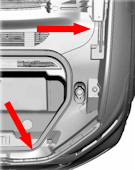Mustang Mach-E As we ready our next video on jump starting electric vehicles (EVs) with dead 12-volt start batteries, we find that getting inside a Ford Mustang Mach-E in this state is a challenge, to say the least. Ford does not supply a vehicle key or a key cylinder to use it in. In a …
Tag: Ford
Permanent link to this article: https://dashboardsymbols.com/2025/07/lightning-and-transit-ev-jump-starting-far-simpler-than-the-mach-e/
Permanent link to this article: https://dashboardsymbols.com/2025/07/ford-mustang-mach-e-presents-a-jump-start-problem/
Ford “humbled” by EV progress in China, and remains on track to switch to hybrids
EV progress in China In an interview with Walter Isaacson at the Aspen Ideas Festival and reported by Business Insider, Ford CEO Jim Farley, speaking on EV progress in China, “It’s the most humbling thing I have ever seen. Seventy percent of all EVs in the world, electric vehicles, are made in China.” Not only …
Permanent link to this article: https://dashboardsymbols.com/2025/07/ford-humbled-by-ev-progress-in-china-and-remains-on-track-to-switch-to-hybrids/
NHTSA piles on the recalls
Recalls I missed three days of tracking traffic on X and getting caught up wound up reposting a full 24 recalls from the National Highway Traffic Safety Administration (NHTSA). Today found another six, including another air bag recall, this time from Mazda. What initially got our attention were three back-up camera recalls. These devices have …
Permanent link to this article: https://dashboardsymbols.com/2025/06/nhtsa-pile-on-the-recalls/
Does that EV have a heater?
EV have a heater? Several weeks ago, when we were still in the grips of some pretty cold weather, I was asked, “does the EV have a heater?” As it happens the questioner was joking. However, it points out a problem that electric vehicles (EVs) still have: there is a sense in the everyday that …
Permanent link to this article: https://dashboardsymbols.com/2025/03/does-that-ev-have-a-heater/
Ford got it right too…
Ford got it A few days ago, we castigated the industry for adding too many drive modes and credited Lexus with adding an Auto mode to relieve their drivers of the added headache. We also specifically called out Ford, when in fact Ford got it right too! We were so caught up in Ford adding …
Permanent link to this article: https://dashboardsymbols.com/2025/01/ford-got-it-right-too/
Drive modes run amok — @Lexus creates an answer
Too many drive modes In November (2024) we reported that our two main drive mode pages held over 90 drive modes and every manufacturer update adds more. The number now exceeds 105 and does not include another 25 modes related to electric vehicles (EVs) and EV range extension. Then Lexus got it right, although it …
Permanent link to this article: https://dashboardsymbols.com/2025/01/drive-modes-run-amok-lexus-creates-an-answer/




Lightning and Transit EV jump starting far simpler than the Mach E
EV jump starting As we assemble our next EV jump starting video, this one for Ford, we’ve found that procedures for Transit and Lightning EVs are far easier and more straight forward than the Mustang Mach E, as we noted in another post. And it “starts” with the fact that the two trucks use a …
Continue reading